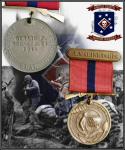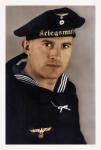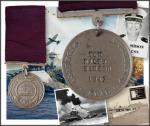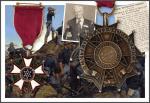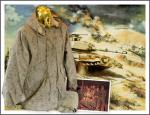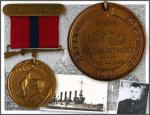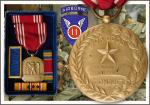Legion of Merit of Col. E. G. Thomas. He was a Span-Am war vet and retired after WWII. This is his biographie The parents of E. G. Thomas (1880-1977), were Welsh converts to the Mormon Church who came to Utah in 1878. Their family eventually consisted of ten children, and Thomas's papers contain at least some information on seven, though the three daughters are poorly documented. Of the sons, there is less information on Alfred, a druggist in Salt Lake City and Richmond, than the other sons, probably because he died in 1919. Two of the other brothers exhibited their Welsh heritage in a lifelong love for vocal music: Warren John "Jack" Thomas, who was a railroad passenger agent, was business manager for several well-known musical groups in Salt Lake City, including the Mormon Tabernacle Choir. Moyer Delwyn "Dell" Thomas, a Rhodes scholar with no fewer than four degrees from Oxford University, who was employed as an agricultural chemist with American Smelting and Refining, was Vice President of the National Gymanfa Ganu Association of Welsh singers. Elmer Thomas received an extremely limited formal education, yet enjoyed a distinguished career as a military officer in the U.S. Army Quartermaster Corps and the Corps of Engineers. He completed the eighth grade, then was admitted to the University of Utah's preparatory program in mining engineering. When his Utah National Guard unit was called to active duty in 1898 for the Spanish-American War, Thomas dropped out of the University and never returned. Thomas served as an enlisted man, a bugler, in the Philippine Islands for a year. Instead of returning to school upon his return, he went to work for the Oregon Short Line Railroad, where he was employed for fifteen years, and for the state as Auditor of Counties. Thomas's experience in the supply, purchasing, and mechanical departments of that railroad evidently impressed the army, for when he re-enlisted in 1917, he was given a commission. He was to serve for nearly four decades, retiring as a full colonel well after the end of World War II. Thomas's papers are full of high praise from others for his expertise as a Quartermaster, and he served in a number of important and far-flung posts in this country and in the Territory of Hawaii. Most prestigious, no doubt, were two periods of service with the Quartermaster General's office in Washington, D.C., where he traveled extensively to inspect and report upon construction and supply operations. He also served two periods of duty in Utah, one at Fort Douglas from 1929-1931, then in Ogden and Salt Lake City from 1940-1943. During the latter period, Thomas built virtually all of the military installations in Utah that were created as a result of World War II, spending some $165,000,000. After his retirement in 1946, Thomas managed the LDS Church's Eagle Gate properties for a time, and served two terms in the Utah State Legislature (1953-1957). For one thing, he felt that army life, which kept him on the road and separated from his family much of the time, compromised his effectiveness as a husband and father. He said, "I regret very much that I stayed in the Regular Army because we would have made our home in Salt Lake and would have grown up with the community and been a respected part of it. Instead of going around the country as we did. However at the time I thought I was doing everything for the best but I have long since realized my mistake." Thomas died at age 97 in 1977. He served as a bugler in Co A. Utah Light Artillery in the Philippine Islands. On April 6, 1898, Congress declared war on Spain and President William McKinley organized United States forces for the "Splendid Little War." Of the tens of thousands of regular, volunteer and National Guard (Militia) troops who served, 343 Utah Guardsmen saw service in the Philippine Islands. On May 1st, after the Navy's stunning victory at Manila Bay, McKinley authorized an invasion force to capture the Philippine archipelago from Spain. Organized into two batteries, the Utah "Light" Artillery mustered into federal service on May 9, 1898 at Fort Douglas, Utah. Shortly thereafter, at Camp Merritt near San Francisco, the Utah Artillery became part of Brig. Gen. Francis V. Greene's brigade of the U.S. VIII Corps under the command of Maj. Gen. Wesley Merritt. Leaving San Francisco, Greene's brigade first raised the U.S. flag in Guam and then arrived on the island of Luzon on July 17, 1898. In the Philippines, 15,000 Americans not only faced 13,000 Spanish soldiers but a second army of some 12,000 Philippine rebels under Emilo Aguinaldo. The rebels had been fighting for national independence from Spain and hoping for American assistance. When Merritt ordered to keep the rebels out of the fight against Spain, the rebels became a second possible enemy. On August 13th, the Utah Artillery supported Greene's brigade as it attacked towards the "old" city of Manila. The battle was predetermined to be a "limited" one in order to preserve Spanish honor and minimize casualties. The rebels, however, made this impossible. As American forces moved quickly against the Spanish defenses, a race to the old city center developed between the Americans and Aguinaldo's rebels. The Utah batteries fired and re-deployed several times providing close and accurate support for the infantry attacks. The Utah Light Artillery continued in federal service for another year and fought in the Philippine Insurrection until returning to Utah in August 1899 Thomas was also Commander in Chief of the United Spanish War Veterans.



